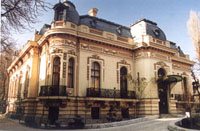|
The mathematical sciences
have been included in the structure of the
Romanian Academy from the very beginning
(August 1867) as a part of the Section of
Natural Sciences, which, in 1879, would
become the Scientific Section.
The list of illustrious mathematicians of
the Romanian Academy begins with Spiru
Haret, who, through his French doctoral
thesis, brought important contributions to
the field of celestial mechanics. This
thesis stirred much interest during that
epoch, and was even included in the
celebrated treatise of the great French
mathematician Henri Poincaré. More recently
the name of Spiru Haret was assigned to one
aspect of the lunar topography on the dark
side of the Moon. As Minister of Public
Instruction, he reformed the Romanian
education system at every level, having been
inspired by the French system, thus
permitting our country to step into the
modern era. Also, he foresaw the application
of mathematics to sociology, drawing up the
theory of social mechanics.
|

|
The Club of
the Academy Members |
David Emmanuel also
played a major role in the same generation
of forerunners. He inaugurated the research
of algebraic geometry in Romania and
distinguished himself through courses on the
theory of functions.
Romanian mathematical research in the first
part of the 20th century was heavily
influenced by Gheorghe Titeica, a highly
reputed geometrician, by Traian Lalescu, who
wrote the first monograph about integral
equations which was published in Paris at
the beginning of the century, and by
Dimitrie Pompeiu, one of the greatest
Romanian analysts, who introduced numerous
new concepts and ideas still frequently used
in the field of analytical mathematics, some
of which bear his name (the
Pompeiu-Hausdorff metric, for example).
Simion Stoilow was the creator of the
Romanian school of complex analysis and
postulated certain profound ideas and
effects which won him worldwide notoriety
among scientists (the Kerekyarto-Stoilow
barrier and the Iversen-Stoilow surface, for
example). Victor Vâlcovici studied the
problems of rational and analytical
mechanics, establishing a functional basis
for the variational principles of mechanics
and introduced new methods in the theory of
elasticity and the resistance of materials.
Alexandru Ghika was a trailblazer in
functional analysis and its applications in
quantum mechanics. Octav Onicescu developed
invariant mechanics and, together with
Gheorghe Mihoc, created the Romanian school
of the theory of probability.
The Iasi school of mathematics was
represented by Alexandru Myller through his
work in differential geometry, Octav Mayer
with his studies on projective geometry, and
Mendel Haimovici who contributed to the
Finsler varieties of differential geometry.
Dan Barbilian, who made important
contributions to the fields of geometry,
algebra and number theory and succeeded in
constructing an axiomatics of the geometry
of projective rings was also, under the
pseudonym Ion Barbu, a great Romanian poet
of the interbellum era.
In the realm of astronomy, Gheorghe
Demetrescu established a method for
calculating solar eclipses, Calin Popovici
developed methods for determining the
motions of the Sun and Constantin Drâmba
cleared up a series of questions relating to
the Earth, Moon and Sun.
Gheorghe Vrânceanu brought important
contributions to modern differential
geometry. Tiberiu Popoviciu inaugurated the
theory of higher order convex functions in
mathematical literature and founded the Cluj
school of the theory of approximation and
numerical analysis. Grigore Moisil was the
founder of the Romanian school of the
algebra of logic and informatics. Caius
Iacob applied the results he had obtained
from mathematical analysis to fluid
mechanics, distinguishing himself in the
field of the aerodynamics of compressible
fluids. Miron Nicolescu obtained important
results in the theory of real functions and
introduced the ideas of polyharmonic and
polycaloric functions into the theory of
partial differential equations. For several
years the Director of the Institute of
Mathematics in Bucharest, Miron Nicolescu
was one of the founders of the Romanian
school of mathematical analysis and the
theory of operators, which put him in the
front ranks of world mathematics. He was
President of the Romanian Academy from 1966
to the end of his life. The crude abolition
of the Institute of Mathematics of the
Romanian Academy, an institution for which
he had fought very hard, grieved him such
that he died soon afterwards (in 1974).
Gheorghe Marinescu made significant
contributions to functional analysis and the
theory of distributions.
The great contemporary mathematicians
Jacques Hadamard, Elie Cartan, Paul Montel
and Jean Leray count themselves among the
Honorary Members of the Romanian Academy.
Six mathematical institutes exist within the
Romanian Academy, to whit the Simion Stoilow
Institute of Mathematics, the Gheorghe Mihoc
Center for Statistical Mathematics, the
Caius Iacob Institute of Applied
Mathematics, the Tiberiu Popoviciu Institute
of Calculus in Cluj-Napoca, the Octav Mayer
Institute of Mathematics in Iasi, and the
Institute of Astronomy. Evolved from the
Astronomic Observatory established in
Bucharest in 1908, it now has branch
observatories in Cluj-Napoca and Timisoara,
and coordinated the important international
program ECLIPSA ‘99 on the occasion of the
total solar eclipse in August 1999.
Mathematicians with international
reputations in the scientific world have
worked in these institutions, and many are
currently professors in the great
universities of the world. In Romania,
world-renowned mathematical schools were
created and are still active; some of their
fields of study are the theory of operators,
complex analysis, the theory of potential,
the theory of manifolds, differential
equations and the theory of the optimal
central, fluid mechanics and the theory of
elasticity, the theory of probabilities and
mathematical statistics.
Among the periodicals published by the
Romanian Academy in this domain, several
enjoy an international reputation, such as
Revue Roumaine de mathémathiques pures et
appliquées, Mathematica, Revue d’analyse
numérique et de théorie de l’approximation,
Romanian Astronomical Journal etc. |